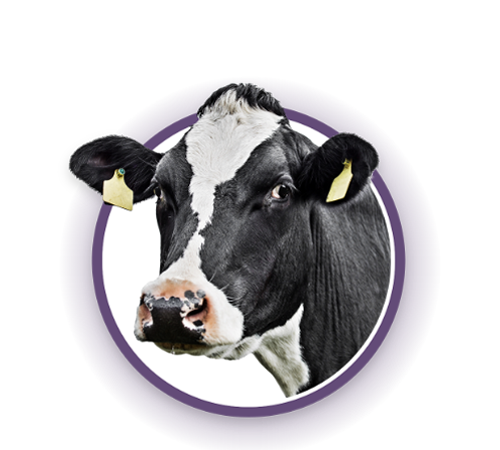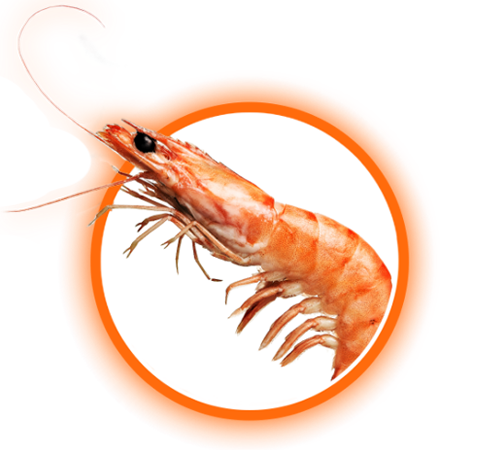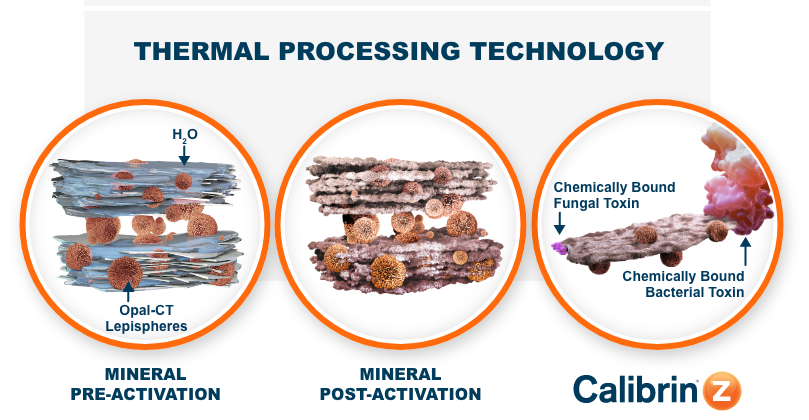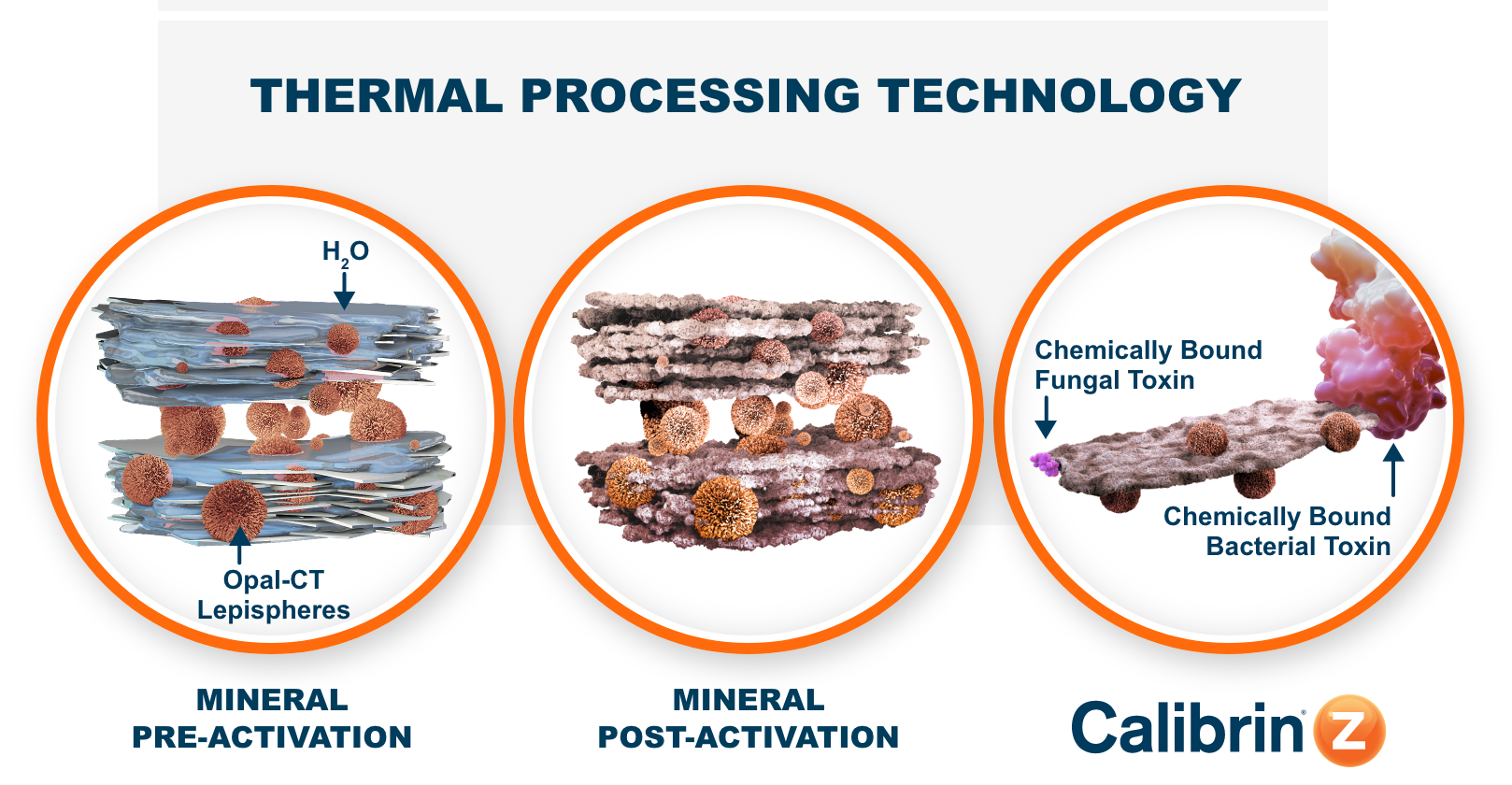Bacterial pathogens such as Clostridium perfringens and Escherichia coli are a leading cause of enteric disease in production animals and a source of economic loss for producers. Found readily in the environment, these bacteria can produce powerful toxins (exotoxins and endotoxins) that damage the integrity and function of the intestinal barrier and reduce nutrient absorption. As a result, bacterial enteritis can cause reduced weight gain, higher feed conversion and in some cases, mortality.
Select Your Species
 Poultry
Poultry
 Swine
Swine
 Dairy
Dairy
 Aquaculture
Aquaculture
Select Your Species
 Poultry
Poultry
 Swine
Swine
 Dairy
Dairy
 Aquaculture
Aquaculture
The poultry industry suffers significant economic loss due to bacterial enteritis, most commonly, necrotic enteritis. The causative agent of necrotic enteritis, C. perfringens, produces toxins that can be 100,000 times more toxic to a bird than mycotoxins. Dietary mycotoxins intensify the effects of bacterial toxins and further reduce bird performance. Natural solutions are available to help protect poultry from bacterial enteritis — and producers from the devastating financial impact of bacterial toxin-induced disease outbreaks.
Bacterial Toxins: Exotoxins and Endotoxins
Bacterial pathogens produce exotoxins and release them into the intestinal environment, while endotoxins (for example, lipopolysaccharide, LPS) are released from the cell wall of gram-negative bacteria (like E. coli) when the bacteria die. Endotoxins can result in the host organism’s elevated temperature, tissue necrosis and, at high levels, death. The virulence of C. perfringens is due to its production of the exotoxins alpha-toxin and NetB toxin.

Mineral Technology That Protects the Intestinal Environment
Due to our unique mineral technology, Amlan International products like Calibrin®-Z protect birds by binding pathogenic bacteria and their toxins in the intestinal lumen. The specific structural properties of our novel mineral, together with our proprietary thermal processing method, enable Calibrin-Z to promote bacterial toxin binding and help prevent intestinal absorption of exotoxins and endotoxins, as well as mycotoxins.
Varium® for Intestinal Health and Feed Efficiency
To help protect birds from bacterial enteritis, Amlan offers a number of mineral-based feed additive options. Patented Varium protects the intestine from pathogens and their toxins, but its formulated ingredients also energize the epithelial cells of the intestines to better defend against pathogen invasion and maintain adequate nutrient absorption. Varium also gently stimulates intestinal immune cells to allow the bird’s biological systems to naturally defend against pathogens.
NeutraPath®: For Natural Pathogen Control
Using a proprietary blend of essential oils, medium-chain fatty acids and our mineral technology, NeutraPath delivers a potent synergistic effect against bacterial pathogens and their toxins. Engineered to neutralize bacterial toxins, NeutraPath’s antibacterial formula destabilizes bacterial cell membranes and disrupts cell-to-cell communication (quorum sensing) between pathogenic bacteria.
Calibrin-Z Binds a Broad Spectrum of Bacterial Toxins and Mycotoxins
Calibrin-Z is our mineral-based feed additive that binds a broad spectrum of bacterial and fungal toxins, including E. coli heat-labile and Shiga-like toxins, as well as polar and nonpolar mycotoxins.
Proven Natural Solutions for Bacterial Enteritis
Bacterial pathogens in the gastrointestinal tracts of dairy cattle can produce toxins that damage the protective intestinal barrier, reduce nutrient absorption and decrease cow performance. However, natural solutions are available from Amlan to support dairy cattle intestinal health and help producers prevent the financial losses associated with a bacterial enteritis outbreak.
Pathogenic Bacteria Produce Exotoxins and Endotoxins
Bacterial pathogens like E. coli and C. perfringens — causative agents of bacterial enteritis — can produce exotoxins that damage the intestinal environment. Endotoxins (like LPS) are released from dead gram-negative bacteria. Both of these toxin types can reduce nutrient absorption and cause production loss in dairy cattle.

Bind Bacterial Toxins in the Intestine
Amlan feed additives, like Calibrin®-Z, are based on our single-source mineral that has unique structural properties and is tailored to each product by our proprietary thermal processing. This allows Calibrin-Z and our other mineral-based feed additives to bind bacterial toxins and reduce the harmful effects of pathogenic bacteria in the intestinal environment of dairy cattle.
Calibrin-Z Binds Multiple Bacterial Toxins
Calibrin-Z is our mineral-based feed additive that binds a broad spectrum of bacterial toxins, including E. coli and C. perfringens exotoxins, as well as polar and nonpolar mycotoxins.
Bacterial enteritis is a common condition of recently weaned piglets, due to intestinal and immune dysfunctions caused by the stress of weaning. Recent moves toward antibiotic-free production have made bacterial enteritis control more difficult; however, natural solutions are available to support swine intestinal health and help producers prevent the financial losses associated with a bacterial enteritis outbreak.
Bacterial Toxins: Exotoxins and Endotoxins
Enterotoxigenic E. coli (ETEC) and Clostridioides difficile (formerly known as Clostridium difficile) are often the causative agents of bacterial enteritis in swine, and both produce exotoxins as part of their virulence package. Gram-negative bacteria (like ETEC) also release endotoxins (for example, lipopolysaccharide, LPS) from their cell wall when they die. These exotoxins and endotoxins damage the intestinal lining, causing diarrhea and, at high levels, death.

Mineral Based Products that Adsorb Bacterial Toxins
Our mineral-based feed additives, like biotoxin-binding Calibrin®-Z, adsorb pathogenic bacteria and their toxins in the intestinal environment of swine. The distinctive properties of our mineral, together with our proprietary thermal-processing technique, allow Calibrin®-Z and our other mineral-based products to bind pathogenic bacteria and help prevent intestinal absorption of harmful biotoxins.
Calibrin-Z Binds Multiple Bacterial Toxins
Calibrin-Z is our mineral-based feed additive that binds a broad spectrum of bacterial toxins, including ETEC-produced heat-labile toxin and C. difficile exotoxins, as well as polar and nonpolar mycotoxins.
NeoPrime® Defends Against Bacterial Pathogens
NeoPrime uses a synergistic blend of natural ingredients to reduce the pathogenic challenge level in the intestines of swine while also energizing intestinal epithelial cells and gently stimulating the intestinal immune system.
NeutraPath®: For Natural Pathogen Control
Engineered to neutralize bacteria and their toxins, NeutraPath’s proprietary blend of essential oils, medium-chain fatty acids and our mineral technology destabilizes bacterial cell membranes and disrupts cell-to-cell communication (quorum sensing) between pathogenic bacteria. By using its bactericidal and bacteriostatic abilities, NeutraPath can reduce the pathogen and toxin load, helping to prevent bacterial enteritis.
Proven Natural Solutions for Bacterial Enteritis in Swine
Farmed aquaculture such as shrimp, tilapia and salmon are susceptible to the same bacteria-related production losses as land animals. For example, exotoxins secreted by Vibrio parahaemolyticus cause early mortality syndrome in shrimp, which costs the industry billions of dollars annually. However, Amlan’s natural mineral-based feed additives can provide an effective alternative to traditional pharmaceuticals by binding bacteria-produced toxins that cause much of the clinical damage and loss.
Amlan Mineral Technology Protects the Intestinal Environment
V. parahaemolyticus can compromise the digestive system of shrimp when its toxins proliferate in the gut and then enter the hepatopancreas to destroy this vital organ. Our unique mineral technology allows our feed additive Calibrin®-Z to protect the hepatopancreas by preventing toxins from entering the organ. When bacterial toxins (and mycotoxins) flow through the gut, they are bound by Calibrin-Z and blocked from entry into the hepatopancreas. Normal digestive function then removes the bound toxins.
Calibrin-Z Binds Bacterial Toxins
Calibrin®-Z is our mineral-based feed additive that binds a broad spectrum of pathogens and bacterial toxins, including V. parahaemolyticus toxins, as well as mycotoxins.
Calibrin-Z Reduces EMS Mortality in Shrimp
Multiple studies have shown the benefits of Calibrin-Z to aquaculture production. Adding Calibrin-Z to a shrimp diet caused a significant increase in body weight after 14 days (without bacterial challenge). When shrimp were challenged with V. parahaemolyticus, mortality was significantly reduced in the shrimp fed Calibrin-Z.

